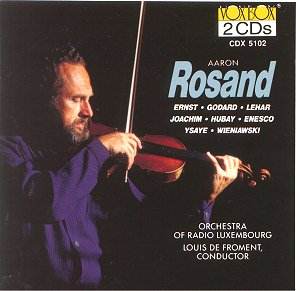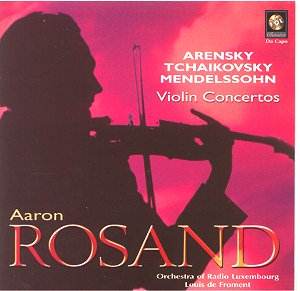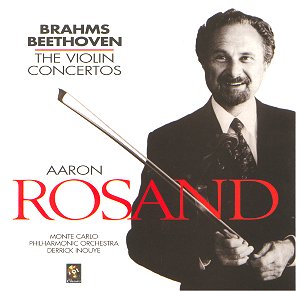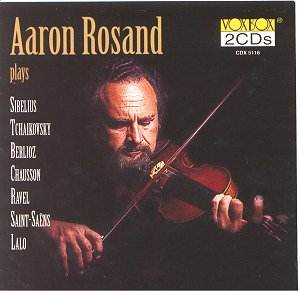A PORTRAIT OF AARON ROSAND
AARON ROSAND in Romantic violin concertos
CD1
JOSEPH JOACHIM Violin Concerto
Hungarian
JENO HUBAY Violin Concerto
GEORGES ENESCO Prelude for solo
violin
CD2
HEINRICH ERNST Violin Concerto
BENJAMIN GODARD Concerto
Romantique
EUGENE YSAYE Chant
d'Hiver
FRANZ LEHAR Hungarian
Fantasy
JENO HUBAY Hejre Kati
HENRYK WIENIAWSKI Concert
Polonaise
 Aaron Rosand (violin) Orchestra
of Radio Luxembourg/Louis de Froment
Aaron Rosand (violin) Orchestra
of Radio Luxembourg/Louis de Froment
 VOXBOX CDX5102 CD1 65.51
CD2 68.03
VOXBOX CDX5102 CD1 65.51
CD2 68.03

It is all down to George Mendelssohn's drive and direction that Aaron Rosand
became known to tens of thousands through recordings of rare romantic era
repertoire. Mendelssohn, Vox's guiding light, would surely have been pleased
with this pairing of discs.
Joachim, the dedicatee of the Brahms concerto, wrote the big-boned Hungarian
concerto (second of three). It is a work alive with romantic character. Rosand
plays it stunningly, taken up as much in the flowing quicksilver as the
étincellante fireworks. He nicely catches the strutting
stiff-necked gypsiness of the central movement complete with the echoes of
Brahms Violin Concerto and the Hungarian Dances. This is far from being a
vapid exercise. Would that other players would take the piece up.
The Hubay concerto is more substantial with some truly delectable writing
as at 2.40 in I and a Berliozian scamper (Symphonie Fantastique) in the scherzo,
a haunted adagio straight out of a Warner Brothers film from the 1940s and
a slashing and ripping finale. The Enesco prelude is all brevity, highland
sentiment and Romanian temperament.
The violin writing in the compact (just over 15 mins) single-movement Ernst
work spills in molten warmth from bar to bar with the display leaning on
the obvious Italianate influence of Paganini. The Godard Concerto is sternly
vigorous, hunting and hunted in tone but, overall, light on the aural palate.
The notes deny its romantic tone calling it salon music for violin and orchestra.
The music seems romantic enough to me!
The Ysaye Chant d'Hiver is a moving little song - sentimental and flowing
sweetly. Such heart-warming writing topples over into Delian expression very
easily. It matters not that the music does not appear all that wintry. The
originality of the orchestral effects (e.g. the upward and downwards slides
at 2.40) make this well worth hearing. A superb piece - make it the track
you sample to be persuaded of the merits of this set. It is perhaps more
than simple coincidence that Efrem Zimbalist senior with whom Rosand studied
was himself a pupil of Ysaye.
Lehár is better known for operetta and vocal music generally. It is
therefore no surprise that the violin the most vocal of instruments, short
of the human larynx and counterpart of the soprano voice, should attract
attention. Here Lehár gypsies and Magyarises with the best in camp
Christmas tree style.
Hubay's name lives on because of Hejre Kati - one of those rip-roaring warhorses
against which aspirant Heifetzs feel they have to test their skills and prove
themselves. There is the usual slow introduction then an increasingly whirling
dance off which sparks fly in welding torch profusion. Rosand takes time
along the way to admire the view - perhaps shed a tear - but is also a masterful
match for the flightier Hungarian stuff.
Wieniawski's Concert Polonaise has that gracious balletic quality usually
associated with his two concertos synthesised with Tchaikovskian atmospherics.
Indeed the opening fanfare seems to be a variant of the fate motif from
Tchaikovsky's Fourth Symphony.
Reviewer
Rob Barnett

AARON ROSAND plays the great and lesser known violin concertos
ARENSKY violin concerto
TCHAIKOVSKY violin
concerto
MENDELSSOHN violin
concerto
 Rosand (violin) Orchestra
of Radio Luxembourg/Louis de Froment
Rosand (violin) Orchestra
of Radio Luxembourg/Louis de Froment
 rec 1973, Stuttgart VOX
DA CAPO 7211 [76.01]
rec 1973, Stuttgart VOX
DA CAPO 7211 [76.01]

Rosand has hardly ever been out of the record collecting public's eye. Because
he has been very much a Vox and Turnabout artist his name has lodged with
great affection with those whose record and CD collecting began at the budget
end. Rosand is however a premium artist at the budget end of the market.
He has made more enduring friends for far longer than many a glistening
wunderkind of the premium shelves.
I first came across Rosand through his ravishing and still unmatched recording
of the Sibelius Humoresques on a Turnabout LP (more of that elsewhere..
This present collection is generously timed and mixes familiar and rare.
Speaking of which the Arensky is a work of slippery mercurial romance
leaning deep into the territory of both Mendelssohn and the syrupy Korngold
concerto without the Korngold's OTT sentimental indulgence. That said the
tunes in the Arensky are not as memorably sculpted as the Korngold. The music
clearly suits Rosand who is no stranger to the idiom. The only blemish on
the brief Arensky is a very subtle metallic 'halo' on the solo violin. This
is absent from the other two works.
The other two works are well loved warhorses but there is no suggestion of
tiredness in the performances which are dashing and impetuous. It does not
displace my reference version (the BMG-Melodiya Oistrakh conducted by
Rozhdestvensky) but the Rosand flies along with pushy élan and much
freshly conceived accenting as at 2.10 in the finale.
The Mendelssohn (an influence on the Arensky) is a surprisingly emotional
and passionate work for 1845 - with many of the same stylistic streams as
the Tchaikovsky. Rosand does not dawdle and as in the Tchaikovsky it is the
impetuous rather than the reflective that carries the day. My preference
is for the sumptuous Campoli recording on Beulah but this is distinctive
and rewardingly listenable.
Good notes and healthy 1970s sound with a natural emphasis on the soloist.
There is some negligible roughness in the orchestra (e.g. horns in first
movement of the Mendelssohn) but nothing to take the honey-glaze off these
top-flight performances by a craftsman of the emotions. The coupling is extremely
generous. Rosand's integrity stares out unblinkingly from every bar.
Reviewer
Rob Barnett

BEETHOVEN Violin
Concerto
BRAHMS Violin Concerto
 Aaron Rosand (violin) Monte
Carlo PO/Derrick Inouye
Aaron Rosand (violin) Monte
Carlo PO/Derrick Inouye
 Monte Carlo, May 1998 VOX
CLASSICS VXP 7902 [77.46]
Monte Carlo, May 1998 VOX
CLASSICS VXP 7902 [77.46]

This disc represents the first of a new generation of Rosand recordings.
It dates from 1998 and rather typically seems to have been ignored in most
quarters. Is this down to the snobbishness which still prevails in relation
to artists who have recorded for bargain labels?
Whatever the rights and wrongs of the reviewing situation an artist recording
these two chef d'oeuvre works is up against a plethora of world class
reputations. Herman Krebbers recording on Philips is one of my favourites.
The orchestral contribution on the Vox disc is brisk and you might apply
the same epithet to Rosand's approach as well. He does not however cut corners
on this most spiritual of concertos - the antithesis of the repertoire with
which Rosand is usually associated. Rosand's violinistic voice is strong
but slender of tone. In the boiling and bubbling rondo Rosand skims and skitters
in smiling roguish charm.
In the Brahms the pace seems less controversial. Rosand is in lovely form
with enchanting tone and delicate pacing. He is not short of attack and there
is plenty of animal excitement from both soloist and orchestra. Do I detect
that the orchestra and conductor were also more engaged by this concerto
than by the Beethoven - only a matter of slight shading but noticeable all
the same. The concerto's finale goes with that snorting and galloping cavalier
spirit that we also find in the finale of Nielsen's violin concerto. I rate
this version of the concerto very highly indeed. Do hear it.
The recording is not of the richest vintage. Playing time is close to the
maximum. The liner notes (by Dan Tucker) are concise and in English only.
Recommended
Reviewer
Rob Barnett
 (Beethoven)
(Beethoven)
 (Brahms).
(Brahms).
AARON ROSAND
CD1 70.58
SIBELIUS Six Humoresques
TCHAIKOVSKY Sérénade
mélancolique
BERLIOZ Reverie et Caprice
SAINT-SAENS Introduction and Rondo
Capriccioso
CHAUSSON Poème
RAVEL Tzigane
CD2 70.41
SAINT-SAENS Violin Concerto No. 3
SAINT-SAENS Havanaise
LALO Symphonie Espagnole
 Aaron Rosand (violin) South-West
German Radio Orchestra/Tibor Szöke VOXBOX CDX 5116 CD1
[70.58] CD2 [70.41]
Aaron Rosand (violin) South-West
German Radio Orchestra/Tibor Szöke VOXBOX CDX 5116 CD1
[70.58] CD2 [70.41]

Strange how fashion moves on. It has left any piece for solo instrument and
orchestra having the effrontery to call itself anything other than concerto
in the wasteland. Such pieces now have a life on CD alone except for the
rarest concert exceptions and competitions (and then usually in a version
with piano). So be it. Though it is strange that when the public is more
easily captivated by the 3 minute sound-byte that these shorter pieces are
not more popular in concert.
These bon-bons are dispatched with affectionate zest by Rosand who plays
them for every subtle turn and dexterous twist and every gramme of neon
excitement. He is in total rapport with his orchestra and conductor. The
recordings are all excellent given their twenty years worn lightly except
for the harsh Berliox Reverie et Caprice.
The Northern sun and moon play in brilliantly poetic limelight over the Sibelius
Humoresques. I learnt these utterly lovable pieces from this recording when
it was issued with a recording of Nielsen's Symphony No. 6 on Turnabout LP.
These are the distilled quintessence of Sibelian temperament - romance in
all its cool lunar intensity. The benign Tchaikovsky Serenade is done with
meditative reserve. The brash edge on the solo violin in the Berlioz piece
compromises what is otherwise a sentimentally doleful performance. The
Saint-Saens Introduction and Rondo Capriccioso has been well done by many
violinists (Ulf Hoelscher is one of my favourite recordings - EMI). Rosand
turns in an exotic performance - accented balletically and not short on crackling
energy bursts. In the case of the rather revolutionary Chausson Poème
I have recently heard the Vadim Repin version on Teldec and prefer the richer
air brought about through the plusher modern EMI recording. The Chausson
is a terribly neglected work forward-looking, meditative, with touches of
Delius. Hearing the Rosand again I am torn. Rosand seems to put his all into
this music and it pays in dividends of eloquence. The Ravel Tzigane I first
heard during the early 1970s on a Philips Universo LP played by Arthur Grumiaux
- a most affecting performance more effective, I thought, in its fanciful
introspection than in the flyaway acrobatics. Rosand is good in both.
The second disc breaks the mould by including a work which calls itself
'concerto'. Saint-Saens' Third is a true warhorse having been much recorded
by all and sundry amongst the violinistic brethren. The three Saint-Saens
concertos have charm, Beethovenian gravitas (from the violin concerto, that
is) and some flashy witchery but they lack the exoticism of the Caprice Andalou
(would that Rosand would tackle that work!), the Havanaise, and the Introduction
and Rondo Capriccioso. Rosand matches the requirements of this work most
beautifully but I do not find this concerto the most involving of pieces
at the best of times lacking the very melodic distinction that marks out
his second piano concerto and third symphony. It always strikes me as a work
that is going through the romantic motions.
The Havanaise is a different matter altogether and while I have fond memories
and great affection for the Leonid Kogan version Rosand is all quiet grace,
restful smiles, sprinting brilliance, sparks flying everywhere. Next time
Class Fm (or its equivalent elsewhere ) wants to try a soupçon of
soothing music which has true character they should reach for this track.
A recording and performance to count alongside the best. You will want to
play it again and again.
From Havanaise it is a natural progression to move to Lalo's once ubiquitous
Symphonie Espagnole. With its glaring Brahmsianisms, stock Spanishry, deep
reserve of charm and mercurial mood changes it is a work still capable with
small effort of winning friends. I wonder what would have happened if Lalo
had just called it a concerto. By the way the Rhapsodie Norvégienne
is also well worth seeking out. I remember it being coupled with the Martinon
recording of the Namouna suites and making quite a splash. The Repin on Teldec
is a richer recording but for the same price you can have Rosand and almost
three times as much music as the Teldec offers.
There is some stunning playing on offer here: stunning both in the depths
of expression and in spark-striking pyrotechnics.
Recommended.
Reviewer
Rob Barnett

NOTE
It seems that sometime in 2000 radio tapes of Rosand with the North German
Radio Orchestra will be issued on commercial CD. There should be three CDs
featuring 4 or 5 concertos. Here's hoping we get some more out of the way
material.
Rosand is also recording the Sibelius and Khachaturian concertos with the
Malaysian Philharmonic Orchestra and Kees Bakels. With the North German Radio
Orchestra he is doing the Bruch Scottish Fantasy and the first two concertos.
I hope that he can also be persuaded to record the Klaus Egge Concerto -
which is within his performing portfolio.

![]()